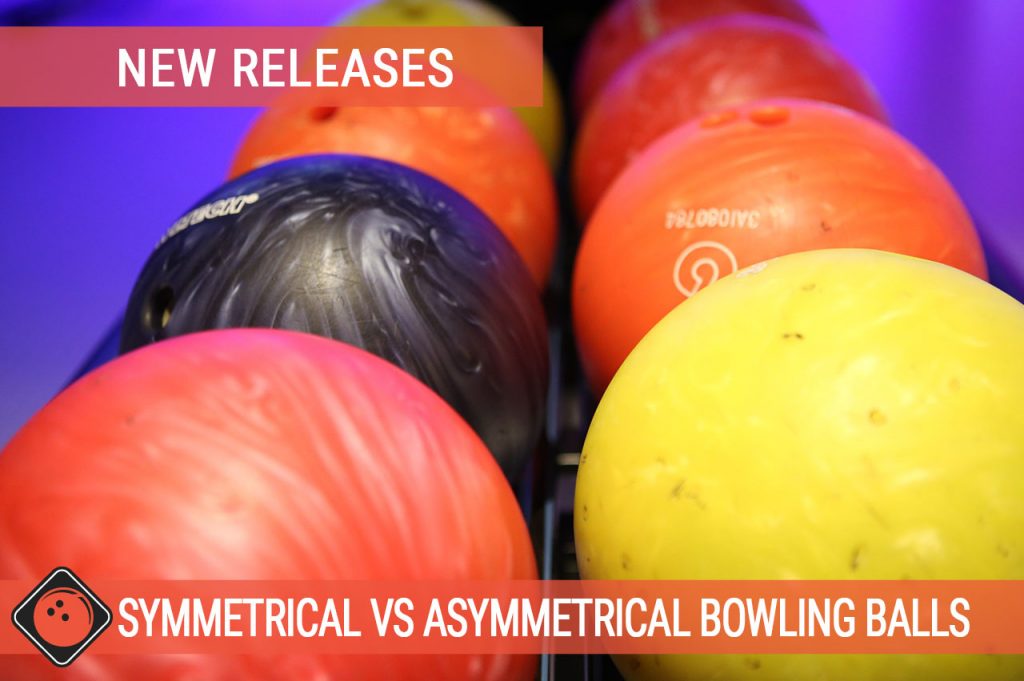Fathoming symmetric vs asymmetric bowling balls helps you milk the best weight block for all its worth as you try a different tack. Bowling ball symmetry depends on the dynamics of the ball’s structure and also affects motion down the lane.
New Symmetrical Bowling Balls Releases: Comparison Chart
Table could not be displayed.* Core Specifications are for a 15 lb bowling ball.
With a non-symmetrical core, the weight block generates increased torque from the ball’s spin with a deviation from a straight-line trajectory and the desired curve approach down the lane. Symmetrical cores refer to those balls without an extensively high intermediate differential.
New Asymmetrical Bowling Balls Releases: Comparison Chart
Table could not be displayed.* Core Specifications are for a 15 lb bowling ball.
Asymmetrical weight blocks contain three distinct primary mass moments of inertia with a differential and an extremely high intermediate differential. Asymmetrical cores render a more angular motion than symmetrical versions.
8 Things To Consider About Symmetrical vs. Asymmetrical Bowling Balls

1. On-Lane Performance
Bowlers attuned to an asymmetric core require additional help curving best bowling ball. They rev up like a streak of lightning and sweep the board with a highly aggressive pattern downhill all the way. Asymmetrical balls shine through in tons of oil and longer patterns without higher friction.
Symmetrical balls with a smoother surface create a benchmark kind of reaction allowing better control. Symmetrical weight blocks contain two primary moments of inertia while asymmetrical ones have three.
The higher degree of asymmetry facilitates extreme dynamic motions for asymmetrical models. However, other factors such as coverstock, structural composition and design also affect on-lane performance.
2. Radius of Gyration
- Symmetrical cores have a radius of gyration values of the Y (high RG) while the Z (intermediate RG) hinge does not vary by more than 5 percent of the overall differential of the bowling ball.
- The RG values in the Y and Z axes of asymmetrical cores vary by more than 5 percent.
- Symmetrical drilled bowling balls render small differential proportions. Smaller differential proportions will create a seamless, controllable motion.
- Asymmetrical drilled balls exhibit a distinct, angular movement. The balls can carve out more space at the break point while they respond to friction more rapidly at this spot than their counterparts.
3. Amounts of Track Flare
- Asymmetrical balls tend to produce considerable amounts of flare for extended pin-to-PAP distances. A 6-inch pin-to-PAP distance pattern on a symmetrical weight block will generally result in an extremely low-flaring ball.
- For a solid asymmetrical, a 6-inch pin-to-PAP distance pattern creates an extremely high-flaring ball.
- Accordingly, asymmetrical balls provide the pro shop with more reaction choices than symmetrical ones.
- Symmetrical balls contain two motion turning parameters, viz. pin-to-PAP distance and pin buffer. Asymmetrical balls create a third variable known as preferred spin axis relative to your PAP.
- Higher undrilled intermediate differential makes the PSA position more significant.
4. Finger Holes Drilling
The two types also differ on drilling. Symmetrical bowling balls have the core oriented relative to the operator’s positive axis spot while gripping holes depends on the position of the pin. They highlight a low RG of the structure and the CG marker.
Conversely, asymmetrical versions use the pin or the “mass bias” marker highlighting the position of the high RG axis. Moreover, some layouts perform different on very asymmetrical balls in contrast to symmetrical types.
Manufacturers bear in mind a predetermined set of undrilled mass characteristics such as low RG, the overall differential and intermediate differential. The weight block’s geometry radically affects the mass properties.
5. Benefits of Asymmetrical Cores
6. Variations of Symmetrical Cores
Symmetrical cores branch off into axis-symmetry geometry and non-axis-symmetry. A bowling ball weight block with axis-symmetry geometry comes from rotating a two-dimensional outline about the central axis. The light-bulb weight block has become a common type of this core shape which has gained the toehold in the bowling world.
The other non-axis-symmetric core has a more complex geometry but mathematically falls into this class due to its primary mass moments of inertia.
Some balls have an overlap of non-axis-symmetric and axis-symmetric features. The gripping holes or balance hole can reach or miss a core’s axis-symmetric qualities, but with insignificant impacts on the mass properties.
7. Advantages of Symmetrical Cores
8. Other Considerations on Bowling Motion
- Coverstock determines the amount of friction and the ability to hook more aggressively;
- A delicate balance between the core and coverstock affects how the ball travels down the lane;
- RG, intermediate differential and coverstock jointly affect the rolling pattern;
- Bowler skills, lane conditions, axis of rotation and the laws of physics;
- Oil patterns such as medium-heavy or dry surfaces affect spin speed;
- Mass distribution and weight density of the weight blocks or cores;
- Ratio of the total differential/ mass bias strength to intermediate;
- Radius of gyration, conservation of energy, equilibrium, and moment of inertia affect motion.
Closing Thoughts
The borderline between symmetrical vs. asymmetrical bowling balls has not yet become blurred by technological advancements. The balancing weight may lie in the core or a separate component of the structure. Bowling balls with a symmetrical weight block has no specific location for the preferred spin axis (PSA).
They have inconsistent and unpredictable PSAs. The dynamic properties of the ball remain random and unpredictable. Some asymmetrical cores have a structure fine-tuned for better predictability for improved, consistent hook potential and track manageability.
Overall, the two types of weight blocks continue to exhibit structural, functional and on-lane performance divergences. Advanced bowlers will note the subtle differences with a cursory examination.
Read more:
Best bowling shoes
Best bowling ball for left handers
Top urethane bowling ball
Last update on 2024-03-13 / Product Images
